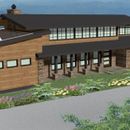Chimney chase insulation
I have read a lot of articles and forum posts about this, but there is not a lot of consensus, and each answer seems very case specific. So, here is my case! I am installing a RSF Focus 320 [Editor’s note: This is a manufactured fireplace with a glass door; the fireplace is designed to burn wood.] in a new construction home in NC with outside combustion air and a hookup to our HVAC system for distributing heat.
http://rsf-fireplaces.com/en/focus-320-woodburning-fireplace#mc
It will be in a chase, the vast majority of which will be inside the envelope. The great room has a 16′ ceiling with an unvented roof insulated with closed cell and open cell foam. See the attached pic for the outside view detailing the exposed portions of the chase.
I would like to get this detail right since we have a similar setup in our current house and we can sometimes see ice on the air inlet for the fireplace despite a lot of insulation in the chase(though it’s an outer wall chase).
The RSF manual, in the section about chases(though they mean outer wall chases) says:
“If the climate in your area is very cold, insulate the chase to the top to keep the chimney warmer, increase the draft, and reduce creosote buildup. We also recommend to insulate the ceiling of the chase just as if it were in the attic space. This will prevent cold air from dropping down through the chase and into the room where the fireplace is installed.”
So my question is about the correct way to insulate. Do I worry only about the area of the chase exposed to the outside? Do I do the entire chase? How does one insulate the roof of the chase? The chimney needs 2″ of clearance, so will that space just be a permanent leak?
Thanks for any and all suggestions.
GBA Detail Library
A collection of one thousand construction details organized by climate and house part










Replies
Kevin,
First of all, you have to comply with the installation instructions provided by the manufacturer of the fireplace.
Second, you have to comply with the installation instructions provided by the manufacturer of the metal chimney.
Some metal chimneys specify that insulation contact is acceptable; others specify that an air space needs to be maintained.
In general, the best type of insulation to use near chimneys is mineral wool insulation, which is fire-resistant.
Needless to say, you need to define your home's thermal barrier. Your home's air barrier must be adjacent to the thermal barrier. This type of chimney chase often introduces air leaks in the thermal envelope unless you get the air sealing details right.
Q. "Do I worry only about the area of the chase exposed to the outside? or do I do the entire chase?"
A. It's a good idea to insulate the entire chase.
Q. "How does one insulate the roof of the chase?"
A. You will extend the "wall" insulation that you plan to install on the walls of the chase -- presumably, mineral wool batts -- all the way to the top, so that the mineral wool touches the metal cap that provides weather protection at the top of your chase.
Q. "The chimney needs 2 inches of clearance, so will that space just be a permanent leak?"
A. Even if you have to maintain a 2-inch air space -- a space without insulation -- you should be able to maintain a tight air barrier with metal flashing and high-temperature silicone caulk.